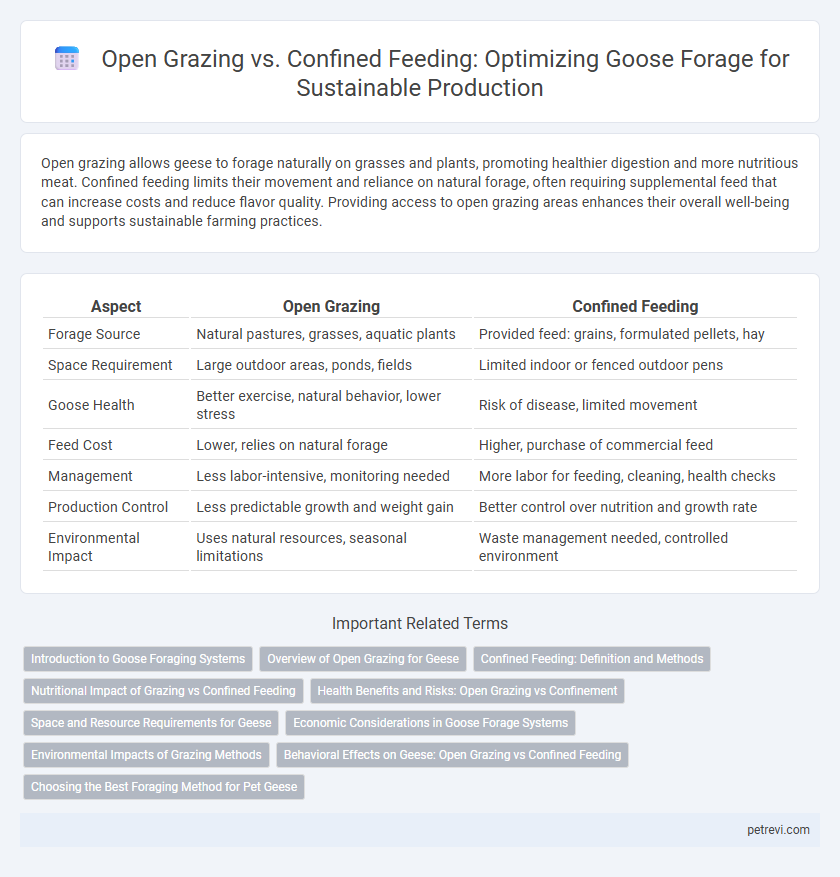Open grazing allows geese to forage naturally on grasses and plants, promoting healthier digestion and more nutritious meat. Confined feeding limits their movement and reliance on natural forage, often requiring supplemental feed that can increase costs and reduce flavor quality. Providing access to open grazing areas enhances their overall well-being and supports sustainable farming practices.
Table of Comparison
| Aspect | Open Grazing | Confined Feeding |
|---|---|---|
| Forage Source | Natural pastures, grasses, aquatic plants | Provided feed: grains, formulated pellets, hay |
| Space Requirement | Large outdoor areas, ponds, fields | Limited indoor or fenced outdoor pens |
| Goose Health | Better exercise, natural behavior, lower stress | Risk of disease, limited movement |
| Feed Cost | Lower, relies on natural forage | Higher, purchase of commercial feed |
| Management | Less labor-intensive, monitoring needed | More labor for feeding, cleaning, health checks |
| Production Control | Less predictable growth and weight gain | Better control over nutrition and growth rate |
| Environmental Impact | Uses natural resources, seasonal limitations | Waste management needed, controlled environment |
Introduction to Goose Foraging Systems
Open grazing allows geese to naturally forage on grasses, weeds, and aquatic plants, promoting diverse nutrient intake and improved animal welfare. Confined feeding restricts geese to controlled diets, often consisting of grains and formulated feed, ensuring consistent nutrient delivery but limiting natural behaviors. Understanding the balance between these systems is crucial for optimizing health, environmental impact, and production efficiency in goose farming.
Overview of Open Grazing for Geese
Open grazing for geese involves allowing the birds to freely forage on pasture, which supports their natural feeding behavior and promotes healthier growth due to access to diverse vegetation. This method improves nutrient intake by enabling geese to consume a variety of grasses, weeds, and insects, contributing to better meat and egg quality. Open grazing also reduces feed costs and environmental waste compared to confined feeding systems, making it both economically and ecologically advantageous.
Confined Feeding: Definition and Methods
Confined feeding for geese involves raising birds in controlled environments where access to natural forage is limited, allowing for better management of diet and health. This method employs pens or enclosures with provided feed such as grains, pellets, and formulated supplements to ensure balanced nutrition. Confined feeding reduces land use, controls waste, minimizes predation risks, and enables consistent growth rates compared to open grazing systems.
Nutritional Impact of Grazing vs Confined Feeding
Open grazing allows geese to consume a diverse range of natural forage, rich in vitamins, minerals, and fiber, which supports better gut health and enhanced nutrient absorption. Confined feeding often relies on formulated feeds that provide controlled energy and protein levels but may lack the variety of micronutrients found in natural pasture. The nutritional impact of grazing promotes improved meat quality and immune function, while confined feeding ensures a consistent nutrient intake but may require supplementation to match the benefits of natural forage.
Health Benefits and Risks: Open Grazing vs Confinement
Open grazing allows geese access to diverse forage, supporting natural behaviors and providing essential nutrients that boost immune health and reduce respiratory issues. Confinement feeding limits exposure to parasites and predators but may increase risks of stress, obesity, and bacterial infections due to restricted movement and denser living conditions. Optimal health outcomes depend on balancing pasture access with controlled environment management to minimize disease risk while enhancing nutritional benefits.
Space and Resource Requirements for Geese
Open grazing allows geese to utilize expansive pasture areas, providing them with natural forage that supports their dietary needs while requiring less concentrated feed input. Confined feeding demands significantly less space but increases dependency on provided feed and water, raising resource costs for maintaining optimal nutrition and hygiene. Space-efficient management can optimize geese health and productivity by balancing natural forage availability with controlled environmental conditions.
Economic Considerations in Goose Forage Systems
Open grazing reduces feed costs by allowing geese to forage naturally on pasture, increasing economic efficiency through lower input requirements. Confined feeding demands higher expenses for purchased feed and housing but can result in more controlled growth rates and potentially higher market value per bird. Balancing initial investments and operational costs is crucial for optimizing profitability in goose forage systems.
Environmental Impacts of Grazing Methods
Open grazing for geese promotes natural forage consumption, enhancing soil health through organic fertilization and reducing the need for external feed inputs. Confined feeding often generates concentrated waste, increasing the risk of soil and water pollution from nutrient runoff. Sustainable grazing methods minimize greenhouse gas emissions and preserve biodiversity by maintaining pasture ecosystems.
Behavioral Effects on Geese: Open Grazing vs Confined Feeding
Open grazing allows geese to exhibit natural foraging behaviors, promoting physical activity and reducing stress indicators like feather pecking. Confined feeding restricts movement, often leading to increased aggression and feather damage due to social stress and lack of environmental enrichment. Behavioral studies highlight that geese in open grazing systems demonstrate higher welfare levels characterized by natural resting, preening, and exploratory activities.
Choosing the Best Foraging Method for Pet Geese
Choosing the best foraging method for pet geese involves weighing open grazing against confined feeding, with open grazing offering natural diet variety and increased exercise that promote overall health. Confined feeding enables precise control over nutrient intake and reduces exposure to predators or environmental hazards, ideal for owners seeking managed environments. Balancing open grazing's benefits with the security of confined feeding optimizes nutrition and safety for domestic geese.
Open grazing vs Confined feeding for Goose forage Infographic

 petrevi.com
petrevi.com